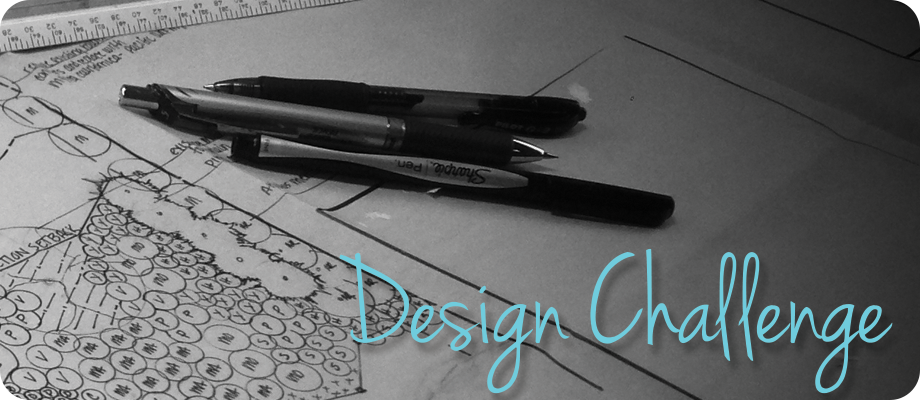
by Susan | Dec 12, 2014 | Plantswoman Design
I get the opportunity to design many gardens for many different reasons. Sometimes the parameters are set by owners, sometimes they have to meet strict standards set by a public entity. It is always fun to have a limited pallet to work with. Recently I was asked to design a buffer between a new house and the shoreline using only native plants. Restrictions about shoreline plantings are becoming more stringent in our area and many different city departments have a say in what you can plant so that makes it challenging. Because of this it is always a good idea to hire a landscape designer to help with this type of challenge.
 The owners originally hired an engineer to design the plan for the buffer area. However, the plantings that the engineer had planned would eventually have obscured the view to the water. After all the reason for building a house by the water is for the view! Instead of having large trees across the shoreline I pushed the larger trees and shrubs on the edges of the property and gathered lower native plants towards the center. A bench at the end of the path near the edge of the bank gives a place to sit and watch the changing sea. The required split rail fence along the edge of the bank is a low barrier to keep people from getting to close to the edge and falling. Planting native Elymus grass helps to hold the bank and give great movement and color.
The owners originally hired an engineer to design the plan for the buffer area. However, the plantings that the engineer had planned would eventually have obscured the view to the water. After all the reason for building a house by the water is for the view! Instead of having large trees across the shoreline I pushed the larger trees and shrubs on the edges of the property and gathered lower native plants towards the center. A bench at the end of the path near the edge of the bank gives a place to sit and watch the changing sea. The required split rail fence along the edge of the bank is a low barrier to keep people from getting to close to the edge and falling. Planting native Elymus grass helps to hold the bank and give great movement and color.
Using a mixture of herbaceous and evergreen low growing plants helps with the preserving the view to the water. Sedums, grasses, and camas line the pathway to the bench. Take a look at the plant list below which represents the required plant quantities and the percentages of evergreen and deciduous for the space.
Do you have special challenges with your garden?
************************************************************************

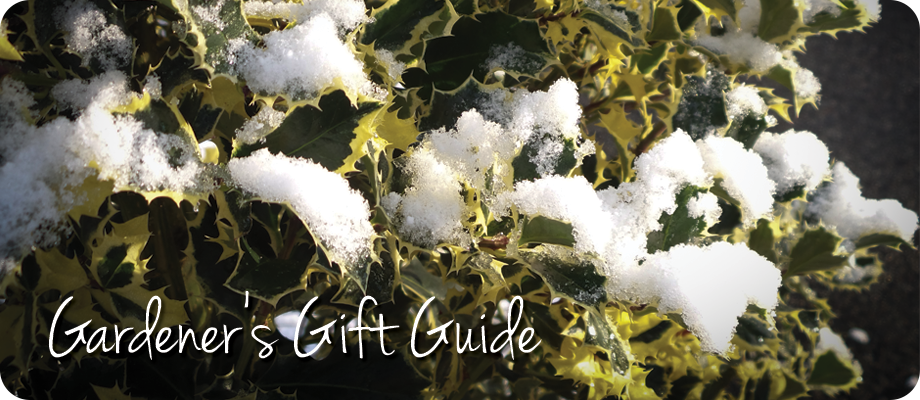
by Susan | Dec 5, 2014 | Plantswoman Design
Every year people ask me what to get me for Christmas, sometimes I say and sometimes I don’t. It is always interesting to see what I get and I think if you have a list it takes the surprise out of it. Of course, there are a few in my family when a list is necessary, but for the most part I’d prefer to have the surprise. This year I thought it might be fun to put together a list of my favorite garden things. The gardener’s in your life will love them too.
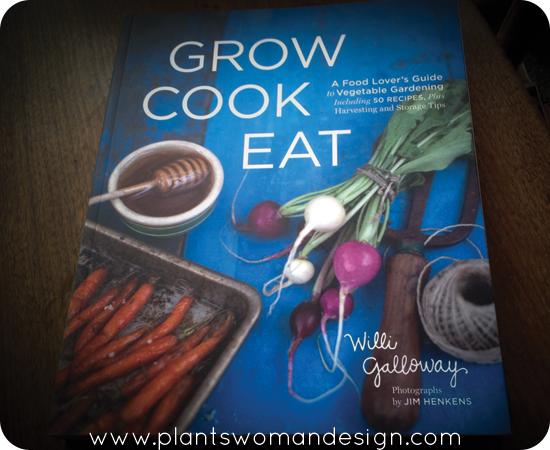
First on my list is about — Food – I love to eat so I cook. One of the best books I found this year is about gardening, growing, cooking and eating (all my favorite things). Grow Cook Eat: A Food Lover’s Guide to Vegetable Gardening, Including 50 Recipes, Plus Harvesting and Storage Tips by Willi Galloway is a great book for gardeners and cooks. I love that it can help you plan your veg garden for the next year and recipes that will inspire you to grow what you want to cook in your kitchen. This book has great advice on how to plant, harvest and store , plus 50 good recipes. Check out Willi’s website at www.digginfood.com.
by Willi Galloway is a great book for gardeners and cooks. I love that it can help you plan your veg garden for the next year and recipes that will inspire you to grow what you want to cook in your kitchen. This book has great advice on how to plant, harvest and store , plus 50 good recipes. Check out Willi’s website at www.digginfood.com.
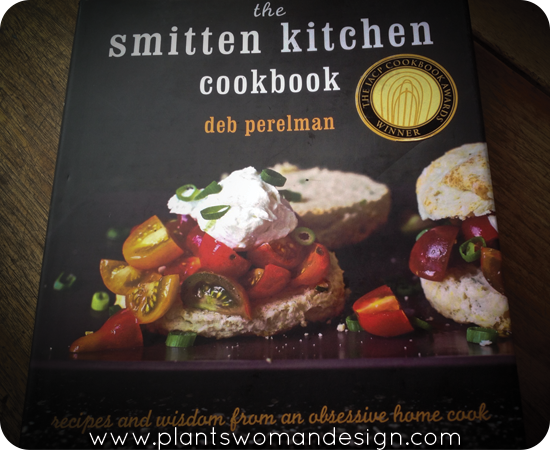
Next on the list is also about food – Humm might be a theme here. The Smitten Kitchen Cookbook is another book I’m in love with this year. Deb Perelman has written a story of her life with a recipe commentary. Her Mom’s apple cake is amazing (yes I still have apples) and the Wild rice gratin even makes Kale taste fabulous. Sometimes I do ingredient based cooking. I find something interesting at the grocery and then look for a way to cook it. This book uses everyday things in the cupboard and then adds a twist . Makes you seem like a fabulous cook and it was really easy.
is another book I’m in love with this year. Deb Perelman has written a story of her life with a recipe commentary. Her Mom’s apple cake is amazing (yes I still have apples) and the Wild rice gratin even makes Kale taste fabulous. Sometimes I do ingredient based cooking. I find something interesting at the grocery and then look for a way to cook it. This book uses everyday things in the cupboard and then adds a twist . Makes you seem like a fabulous cook and it was really easy.
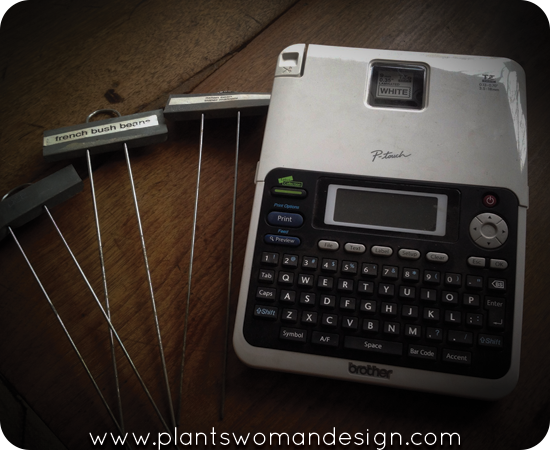 Now for a practical gift… I am a practical person as well and I know gift givers who just have to give something practical. They want it to be ‘useful’. For those people out there I present to you one of the best things for garden labeling. I like to label things in my garden. No, not everything, but I do mark where I planted bulbs and what they were, vegetable rows so I don’t dig over them and species plants so I don’t forget what they are. I also keep records on plants so I know how they do but If I can’t remember them or read the tag it gets very frustrating. Here is my label maker, it is a Brother P-Touch PT-2030 Label Maker
Now for a practical gift… I am a practical person as well and I know gift givers who just have to give something practical. They want it to be ‘useful’. For those people out there I present to you one of the best things for garden labeling. I like to label things in my garden. No, not everything, but I do mark where I planted bulbs and what they were, vegetable rows so I don’t dig over them and species plants so I don’t forget what they are. I also keep records on plants so I know how they do but If I can’t remember them or read the tag it gets very frustrating. Here is my label maker, it is a Brother P-Touch PT-2030 Label Maker . Beside it are a couple of labels. You can see one of the markers has no name….. oh … I did have a name but I can’t read it after just one season. It was marked with the pencil that came with the marker. I have also tried felt markers with the same result. The labels on the other ones are 3 years old. I can change them easily or use them again if I grow the same things. This one is battery operated with an automatic turn off so I can take it outside. Cool!
. Beside it are a couple of labels. You can see one of the markers has no name….. oh … I did have a name but I can’t read it after just one season. It was marked with the pencil that came with the marker. I have also tried felt markers with the same result. The labels on the other ones are 3 years old. I can change them easily or use them again if I grow the same things. This one is battery operated with an automatic turn off so I can take it outside. Cool!
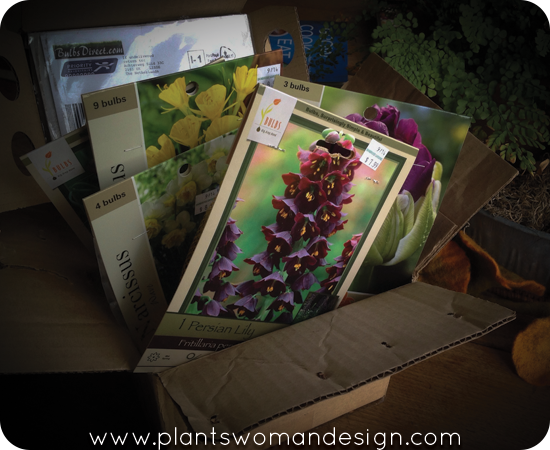
How about a “Box of Color”? I love to give and receive plants. Plan a couple of surprises for the gardener in your life by looking online or at the nursery for something interesting. Bulbs can be purchased and put in refrigerator at 40 degrees and given on Christmas. Vegetable Garden Seeds that are unusual can be purchased and put together with one of the above. I like to order seeds of things that people have commented on in my garden and give them to as gifts. I just got a box from the Netherlands just the other day that contained Crocus sieberi sublimis Tricolor and just the box was so cool! It came from a very long ways and can be planted in my garden!
Need ideas for what to buy? Check out my post on Winter Bulbs, Fall Bulbs, Spring Bulbs, Fall Into Spring. Keep in mind planting times and such. Feel free to ask me any questions you may have.
And now we come to… Power tools. Really, really. Two of the most amazing power tools I have are a Ryobi P515 ONE Plus 18V Cordless Lithium-Ion Reciprocating Saw w/ Anti-Vibe Handle and Toro Electric Blower/Vacuum with Metal Impeller
and Toro Electric Blower/Vacuum with Metal Impeller . Years ago I would use the cordless saw for pruning. I would go into the hardware store looking for blades that would be long enough for big branches. The clerks would ask me what I was doing with it. Then they would laugh and say ‘You can’t use that for pruning’. Really? Well somehow the manufacturers caught on and now they make blades for pruning. It is so light weight that you can stand on a ladder and use it with ease. Your arm does not feel like it will fall off from the sawing motion of a hand saw. Don’t forget the battery! If you have Ryobi or Dewalt tools already you are set but if you don’t make sure to get a Ryobi Compact Battery
. Years ago I would use the cordless saw for pruning. I would go into the hardware store looking for blades that would be long enough for big branches. The clerks would ask me what I was doing with it. Then they would laugh and say ‘You can’t use that for pruning’. Really? Well somehow the manufacturers caught on and now they make blades for pruning. It is so light weight that you can stand on a ladder and use it with ease. Your arm does not feel like it will fall off from the sawing motion of a hand saw. Don’t forget the battery! If you have Ryobi or Dewalt tools already you are set but if you don’t make sure to get a Ryobi Compact Battery too.
too.
The leaf blower with a mulch attachment was a hard sell to me. I don’t like the noise of the blower. (lots written about noise pollution ). But faced with a huge amount of paved surfaces and really tired of sweeping I purchased the Toro Electric Blower/Vacuum with Metal Impeller . It is powerful so it blows the gravel, dirt and leaves. After the leaves are in a pile It can be used to suck them up and chop them into pieces and put in a bag. I love that. You can add to compost, cover plants or throw away. Better than burning them or having them piled only to blow all over again!
. It is powerful so it blows the gravel, dirt and leaves. After the leaves are in a pile It can be used to suck them up and chop them into pieces and put in a bag. I love that. You can add to compost, cover plants or throw away. Better than burning them or having them piled only to blow all over again!
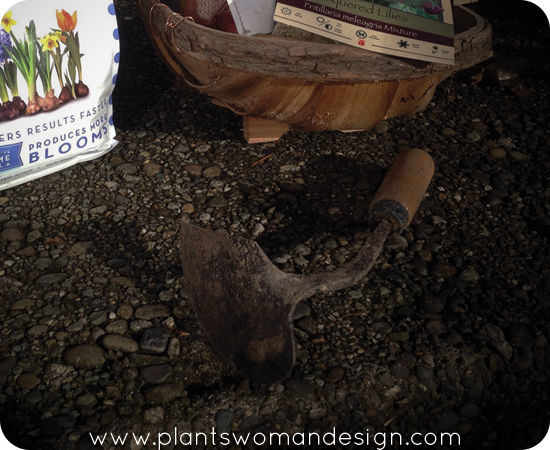
Last but certainly not least is this Hand Plow Ho-Mi EZ Digger , sometimes known as a Korean Cultivator, that is my go to tool when digging in the garden.
, sometimes known as a Korean Cultivator, that is my go to tool when digging in the garden.
Have fun shopping for the gardener in your life. Share this post with those who will buy for you (it’s not exactly a list), or plan for what to get with the return of that unwanted present from your Great Aunt.
*disclaimer: affiliate links are used in this post.
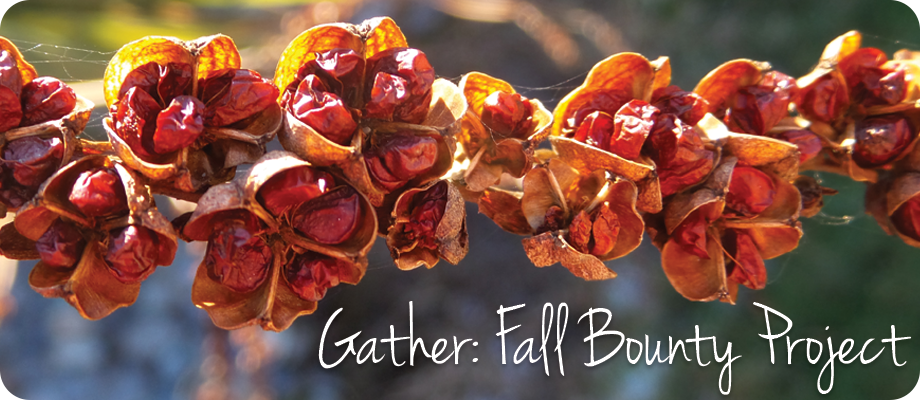
by Susan | Dec 3, 2014 | Natural Decor
Fall is chilling into winter. I went out and gathered some materials last weekend while it was still cold but not raining.
My lovely grandchildren will be coming soon and I want to have a fun gardening thing to do with them. Don’t worry, I will share our creating when they get here but in the meantime do some gathering on your own. I gathered seeds from plants in the garden.
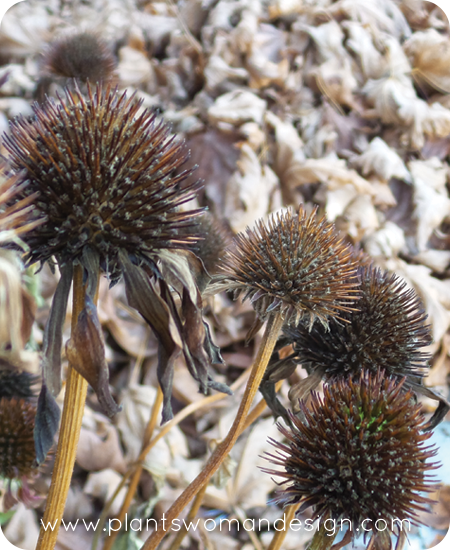
Echinacea
Echinacea, sunflower, rose hip, crocosmia, and grass seed were available in my limited garden. If you have huckleberry, salal, or other berries left gather them also and spread them inside to dry out.
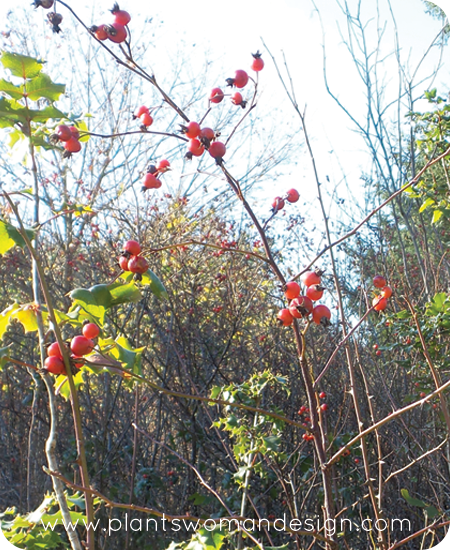
rose hip
We will be making things to feed the birds this winter so gather anything a bird would possibly eat. We will also be using some store bought birdseed.
Look for some conifer cones also. They can be brought in now to dry out. Hopefully they will open up and drop their seeds by the time we need them. If they are already open that is great too.
Check back for our step by step project!
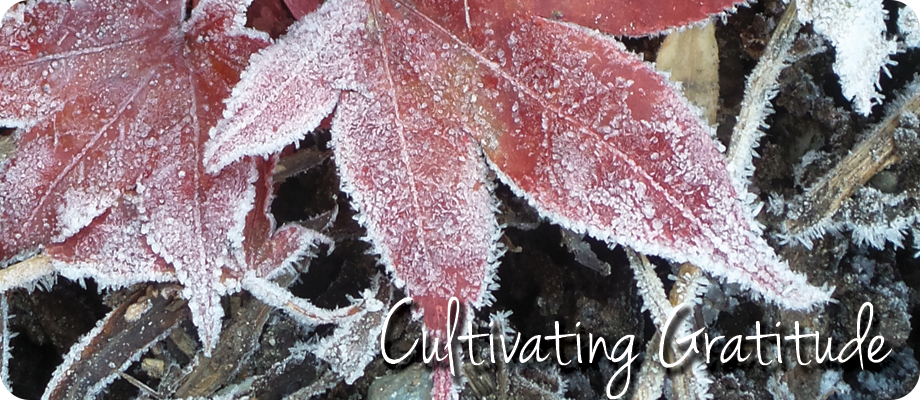
by Susan | Nov 28, 2014 | Plantswoman Design
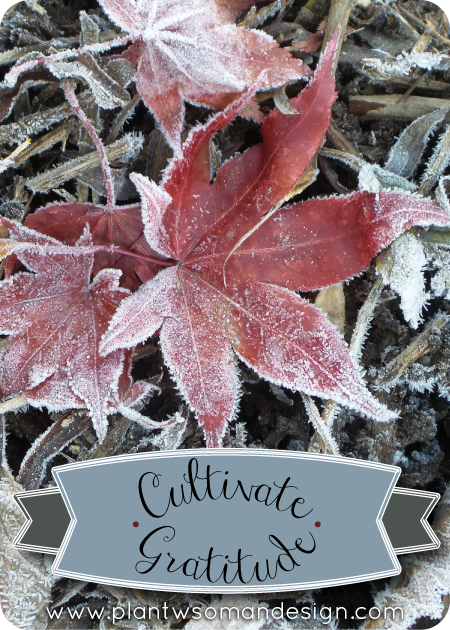 Autumn is such an amazing season. The tumultuous growth and color of summer is fast fading. We had such a long summer and winter jumped into fall before we (and the plants) were ready. Many plants still in full green leaf were surprised by the quick and hard freeze. Just like our plants this year, sometimes we are surprised by things that happen in our lives. New adventures, new directions and different ways to look at things, are often just around the corner.
Autumn is such an amazing season. The tumultuous growth and color of summer is fast fading. We had such a long summer and winter jumped into fall before we (and the plants) were ready. Many plants still in full green leaf were surprised by the quick and hard freeze. Just like our plants this year, sometimes we are surprised by things that happen in our lives. New adventures, new directions and different ways to look at things, are often just around the corner.
This past year has been a season of change for me. Looking forward to the year that lies ahead of me I want to cultivate gratitude. Looking past the changes in my life and really seeing what is around me. Looking at the sky and realizing that those clouds may never look exactly like that again. Seeing the beauty in small things, colors in the dying maple leaf and watching as an eagle stops and perches above the water near me. Touching the earth and knowing the amazing possibilities in the soil. Seeing the face of a person and wondering what their story is and who they love. Taking the time to see people walking by and reaching out a hand to help, share or understand their journey. Cherishing and cultivating the warmth of love given freely.
Gratitude cultivated is my goal for this coming year, to really see the nature around me, to cultivate my appreciation of the beauty in everyday things. I want to see relationships and people grow and mature, share their joy and sorrow and not look away.
Thank you for being a part of my life, for sharing your lives with me, treating me like family and laughing with me. Here’s to a new year of gratitude!
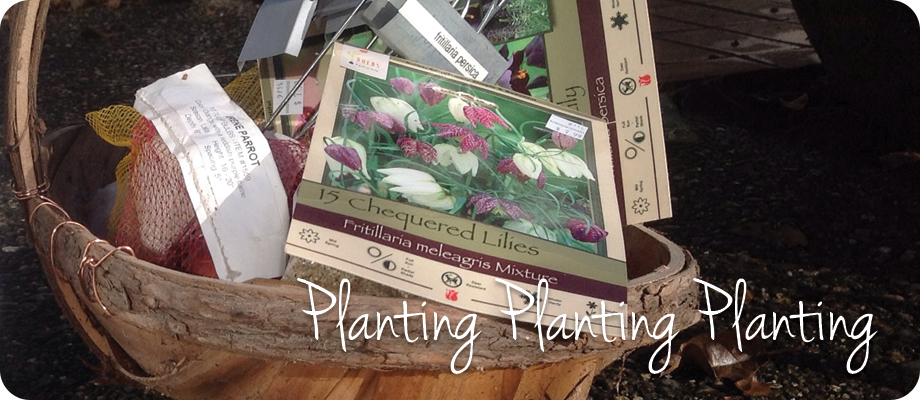
by Susan | Nov 26, 2014 | LB Tutorial: Bulbs & Tubers
In between rain squalls yesterday I ran out and planted the bulbs I had stored in my refrigerator. I had planned on doing it sooner but the freezing weather for almost two weeks delayed the process. I like to group bulbs together for maximum impact, no rows of tulips and daffodils for me.
Here are some step by step planting directions.
1. Scout out a location. I sometimes do it from the inside of the house so I can see where they would be popping up. Two reasons really — It is usually cold and rainy when they appear and it is important to see it from inside to draw you outside to see them up close, and it is usually cold and rainy when you plant them so looking outside with a cup of coffee in your hand is a good way to get ready to go outside and do it.
Think about what is happening around the spot you have chosen. Perennials that will come out later and cover dying foliage is a good background or companion planting. Nothing too invasive or they will not get along well and the bulbs may not be successful over time. Deciduous shrubs are also great because they are not always interesting before the leaves come out and the bulbs will show well against the tracery of branches. Evergreen shrubs that flower in contrast to the bulbs are also a good choice. Like a Azalea Autumn Amethyst with late blooming orange parrot tulips. Purple with orange/purple/red blooms can add wow!
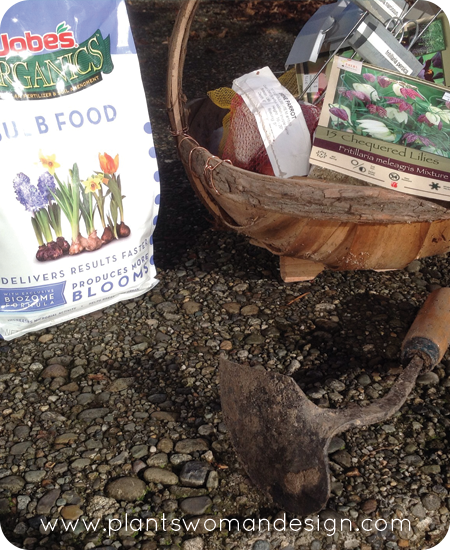
2. Gather your materials together. Grab your bulbs, pre-made markers to identify the location, a ‘claw’ (my favorite gardening tool), and bulb food.
3. Prepare your planting area and plant. Remove any weeds and dig a space with enough depth and breath to accommodate the bulbs. When you plant in a group you just dig one hole per group.
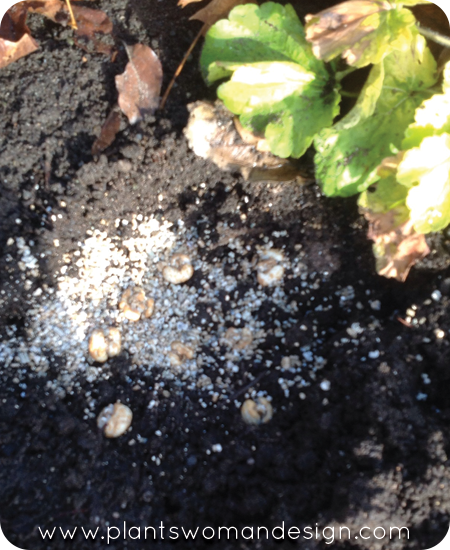
a prepared hole with bulbs and bulb food.
The general rule is depth three times the size of the bulb. This means a one inch bulb would be planted three inches deep. This is most important with small bulbs not to plant too deep. Spread isn’t that important but you want to leave room for them to multiply so I usually leave a fist sized space between them. I add the bulb food on the bottom of the prepared area, then place the bulbs on top with the bud end up. This usually means the pointy end but it is sometimes hard to tell . Look for bits of roots which would have been the bottom.
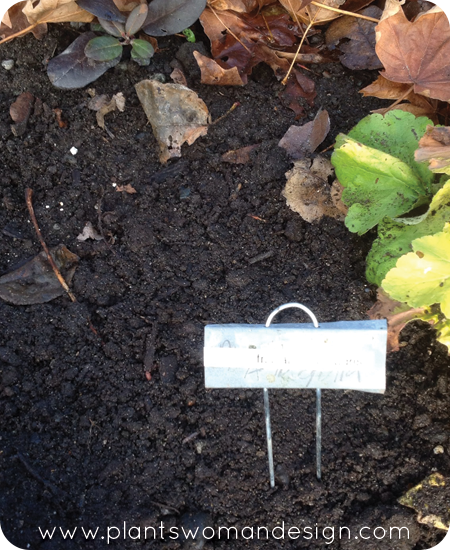
all covered up and labeled
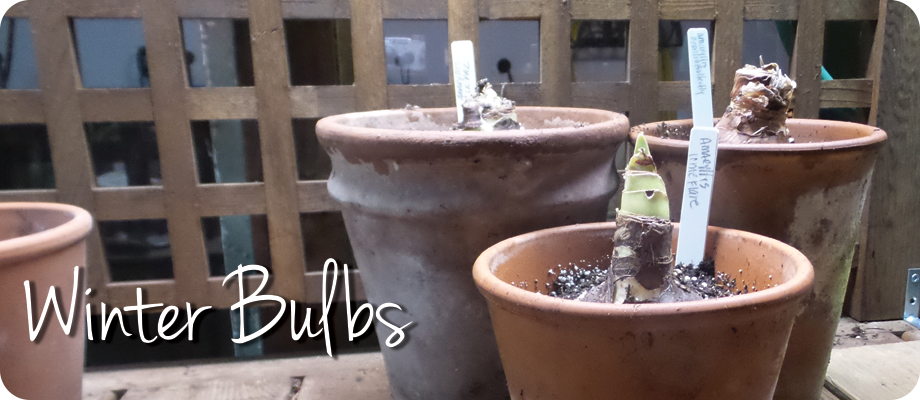
by Susan | Nov 19, 2014 | LB Tutorial: Bulbs & Tubers, Little Bytes
I love the bright colors of winter bulbs at Christmas. Somehow the colors and freshness of living plants with the rest of the Christmas decorations are such a great contrast. Surprisingly almost any bulb can be forced for winter color but I love Amaryllis bulbs so I grow those each year. I usually try and experiment with new varieties. This year Amaryllis Papilio Butterfly beckoned along with Amaryllis Lime Flare and Amaryllis La Paz.

www.easytogrowbulbs.com
The orchid like flower of the Amaryllis Papilio Butterfly, with its lime green petals and dark maroon accents, is truly exotic looking. It takes about 40 -60 days to bloom so getting it in the pot early is important if you want a bloom during the Christmas season.

www.easytogrowbulbs.com
Since we are on the subject of lime green the Amaryllis Lime Flare has brilliant lime green petals which I just love. This one flowers in 40-70 days.

www.easytogrowbulbs.com
Amaryllis La Paz has similar coloring to the Amaryllis Papilio Butterfly but the maroon is more pronounced and the petals thin and recurved back. Exotic looking as well, they sometimes bloom a little later than the Papilio Butterfly. Allow 50-70 days for full bloom.
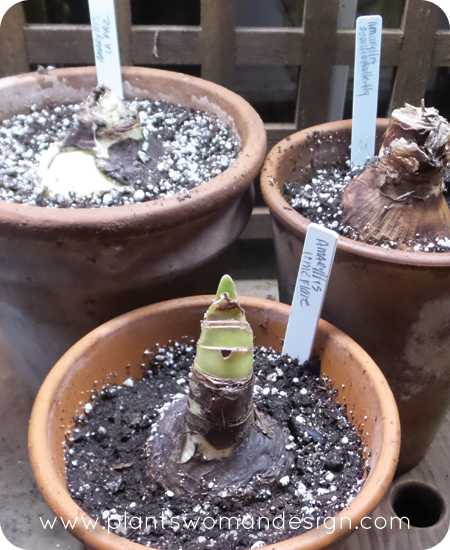 When you get your bulbs, put them in a pot with the top of the bulb about 3 inches above the soil level. Evenly moist soil but not saturated will make the bulbs grow well. Since they don’t like saturated soil keep them a little on the dry side. I like to use heavy terracotta pots and keep them there when I bring them in for display. Putting moss around the base of the bulb gives a festive finished look. Because the blossoms are heavy support is usually necessary. I like to use twigs around the outside of the bulb with either twine or raffia to tie it all together. Dressing it up with ribbon or copper wire is also fun.
When you get your bulbs, put them in a pot with the top of the bulb about 3 inches above the soil level. Evenly moist soil but not saturated will make the bulbs grow well. Since they don’t like saturated soil keep them a little on the dry side. I like to use heavy terracotta pots and keep them there when I bring them in for display. Putting moss around the base of the bulb gives a festive finished look. Because the blossoms are heavy support is usually necessary. I like to use twigs around the outside of the bulb with either twine or raffia to tie it all together. Dressing it up with ribbon or copper wire is also fun.
Mine are in the greenhouse right now. I’m not sure how greenhouse cultivation will effect bloom time but I’ll keep you posted. I would imagine you could manipulated it by planting them at different times to have your bulbs blooming at the same time or through out the holiday season.
Being halfway through November already is a little late in the season for blooms by Christmas. But, do you have a gardener to buy for this year? These wonderful bulbs make a great gift and will provide lovely color this winter to tide your gardener over until spring gets here!
Do you have a favorite holiday bulb or plant? I’d love to hear about it.
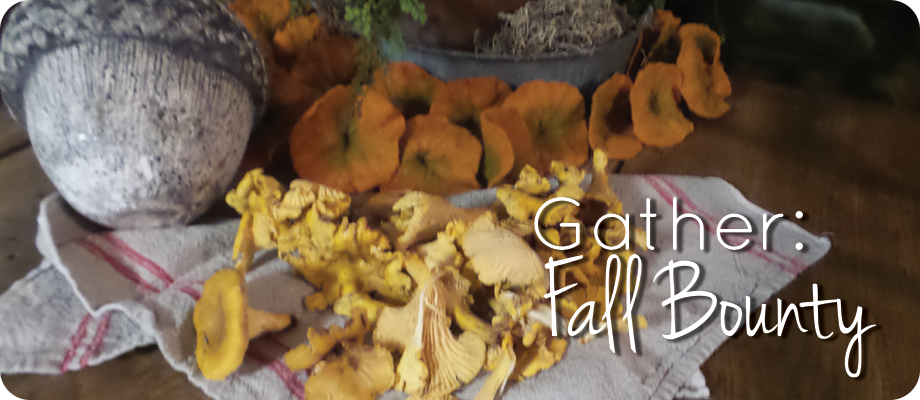
by Susan | Nov 14, 2014 | garden food
I’m so lucky to live in such a bountiful place. We have a long growing season and the woodlands have wonderful things to find and eat. My family owns property near the Olympic National Forest. This time of the year mushrooms abound amidst the moss and fallen leaves of the forest. Chanterelle mushrooms are the ones I search for. Their mild taste is delicious and the yellow coloring is unusual for mushrooms. The key is looking for them between the warm dry summer and the freezing winter weather. The ideal time is when the weather turns to warms days with cool crisp nights and ample rain. The chanterelle will start popping up over night. I love going through the woods with my Mom and Sister. We walk over logs, through small animal paths, and old logging roads. With leaves falling all around they can be very hard to see. Looking around the base of large old coniferous trees between the crevices and roots is the best place to find them.
Here is what I collected… I used these flavorful beauties in a mushroom risotto.
 Many mushrooming spots are coveted and well kept secrets. If you haven’t done it before there are a couple of places that will give a quick class so you can get up to speed on the mushroom hunting protocol. One thing my grandmother taught me was to use a mushroom knife (small blade). The mushrooms should never be pulled out of the ground. Using the knife to cut the mushrooms at the base close to the ground will preserve the area around the mushrooms which contains the spores for new mushrooms. Chanterelle sometimes grow in groups.
Many mushrooming spots are coveted and well kept secrets. If you haven’t done it before there are a couple of places that will give a quick class so you can get up to speed on the mushroom hunting protocol. One thing my grandmother taught me was to use a mushroom knife (small blade). The mushrooms should never be pulled out of the ground. Using the knife to cut the mushrooms at the base close to the ground will preserve the area around the mushrooms which contains the spores for new mushrooms. Chanterelle sometimes grow in groups.
The Environmental Learning Center at Islandwood here on Bainbridge Island is giving classes for a small fee and then will take the students out to search on the grounds of Islandwood.
Here is a glimpse of our favorite spot.
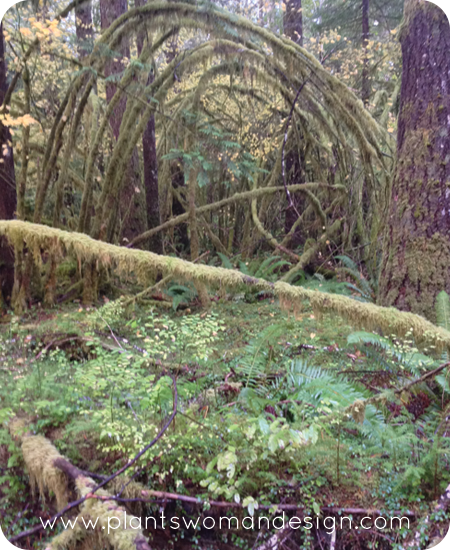
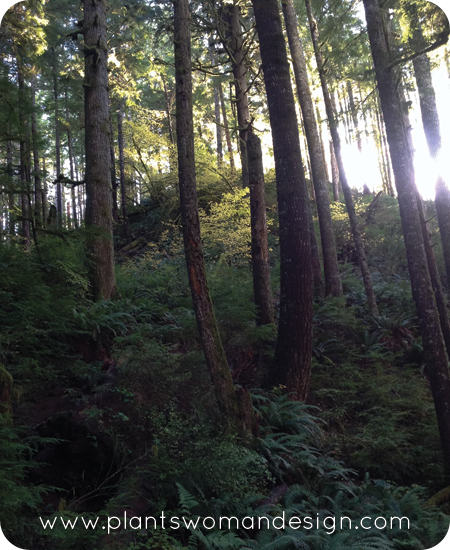
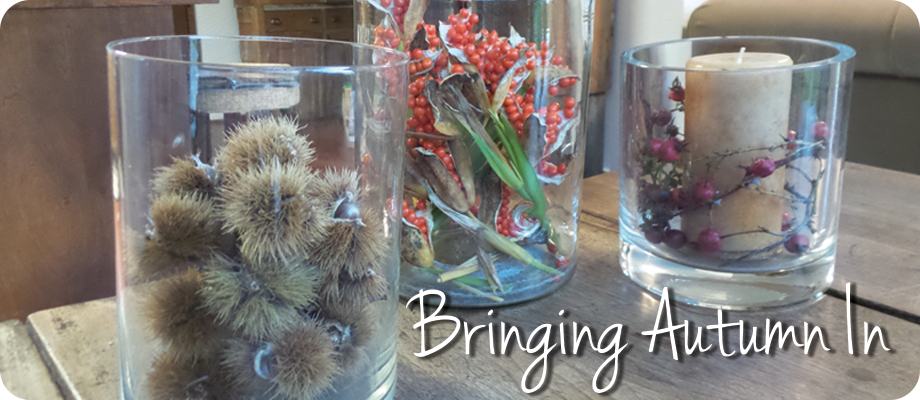
by Susan | Nov 12, 2014 | Natural Decor
Hurricane lanterns are one of my favorite ways to display what I find outside. Often used for placing candles in and protecting them from wind I use them for many other things. These glass cylinders bring things up to eye level and you see them from all angles.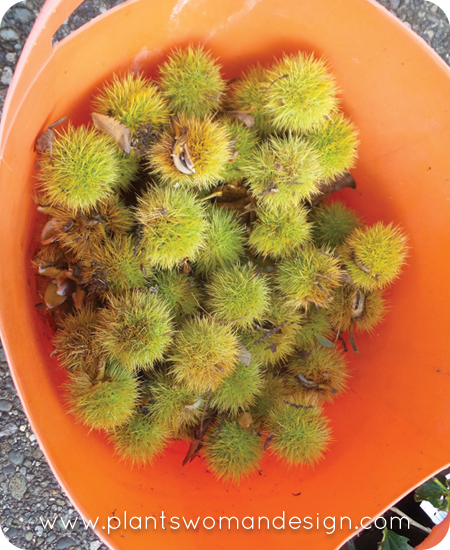
This garden trug was used to gather horse chestnuts from the edge of the road just down the street from me. 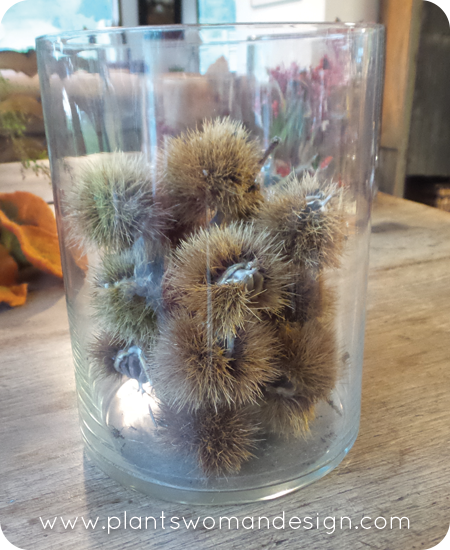
Cleaned up, allowed to dry and stacked in the hurricane cylinder they have great color and texture.
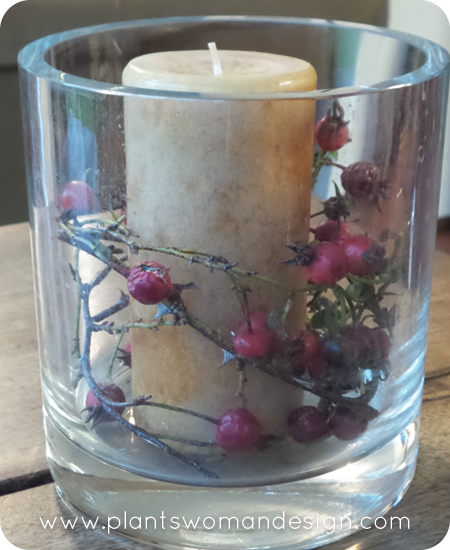 Rosehips from the waters edge at my new house encircle the candle inside this one. I picked the ones with good color and discarded the ones that were blackened or tan. While fresh and pliable I added them around the candle. They will dry like they are and remain fresh for several months. This one in particular can stay through Christmas and beyond.
Rosehips from the waters edge at my new house encircle the candle inside this one. I picked the ones with good color and discarded the ones that were blackened or tan. While fresh and pliable I added them around the candle. They will dry like they are and remain fresh for several months. This one in particular can stay through Christmas and beyond.
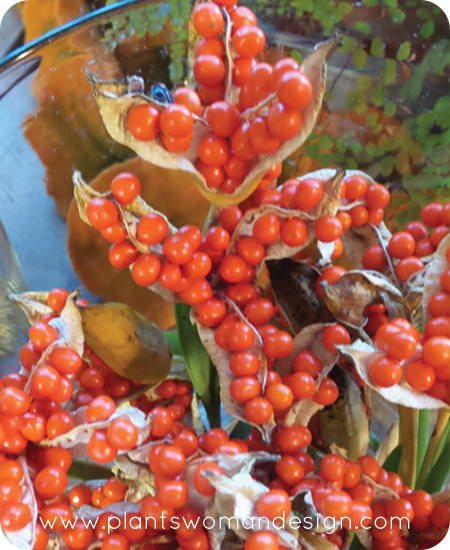 This last hurricane has a seed pod from a summer flower, I assume it is iris foetidissima. I absolutely think this is the most fascinating seed pod. The flower itself is the seed pod and looks like the pod with blossoms on it. It dries well and the seeds are viable for planting next spring.
This last hurricane has a seed pod from a summer flower, I assume it is iris foetidissima. I absolutely think this is the most fascinating seed pod. The flower itself is the seed pod and looks like the pod with blossoms on it. It dries well and the seeds are viable for planting next spring.
These are things I have in my garden and around my house. There are lots of different things to use. Seed Pods of clematis, dried ornamental grass, crab apples, branches with lichen, mini pumpkins, acorns, pinecones, anything that is interesting in a mostly dried out state. Things that are fresh and plump can rot instead of dry so do some experimentation before planing on putting it on the dining room table. Take a trip outside and look around.
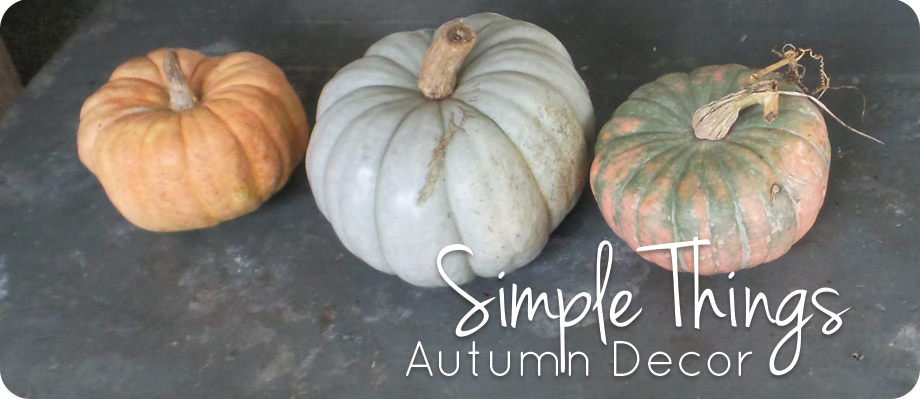
by Susan | Nov 7, 2014 | Natural Decor
Fall decorating can be many things. We see pumpkins, corn stalks, and fall leaves used as decorations. We as gardeners head into harvest season and get the chance to see plants and fruit that we only see once a year. Now is the time to start gathering and foraging. Not only in our garden but in the open ground around us we have the chance to gather what we see and bring it indoors.
I love texture in the garden. This often spills over into the decorating I do inside. Not a big fan of halloween I usually use things that are ‘Autumn’. Decorating for the autumn brings the opportunity to have displays from October through December when Christmas starts.
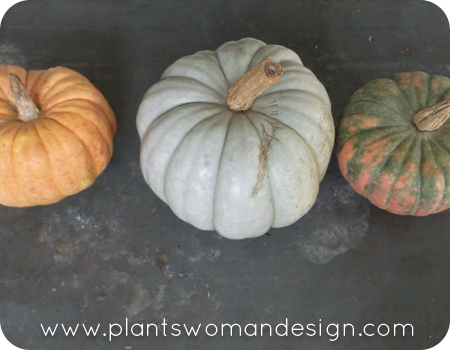 These heirloom squash and pumpkins are beautiful and simple. The patina of the antique galvanized table top echos the colors and soft shine of the blue pumpkin (cucurbita maxima ‘Tramble’). Lumpy and mottled, the orange and green squash look so interesting next to the blue pumpkin. There is a great farm near me that grown these wonderful different looking autumn fruits. Suyematsu Farms have been growing on Bainbridge Island for many years. They grow seasonal produce, pumpkins and squash and even Christmas trees and greens.
These heirloom squash and pumpkins are beautiful and simple. The patina of the antique galvanized table top echos the colors and soft shine of the blue pumpkin (cucurbita maxima ‘Tramble’). Lumpy and mottled, the orange and green squash look so interesting next to the blue pumpkin. There is a great farm near me that grown these wonderful different looking autumn fruits. Suyematsu Farms have been growing on Bainbridge Island for many years. They grow seasonal produce, pumpkins and squash and even Christmas trees and greens.
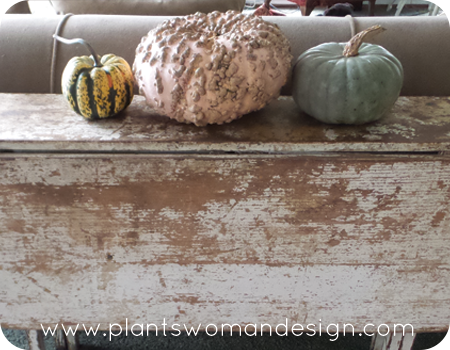 Another antique table displays three more different types of squash. The raised edges of the Brode’ Glaeux D’Eysines (orange pumpkin) is also fascinating in its texture. This fascinating beauty is delicious in pie after using it in display.
Another antique table displays three more different types of squash. The raised edges of the Brode’ Glaeux D’Eysines (orange pumpkin) is also fascinating in its texture. This fascinating beauty is delicious in pie after using it in display.
Have a look at these pumpkins and others at Johnny’s Seeds (many varieties) Musquee de provence, kakai pumpkins and marina di chioggia are three more that I used this year.

 The owners originally hired an engineer to design the plan for the buffer area. However, the plantings that the engineer had planned would eventually have obscured the view to the water. After all the reason for building a house by the water is for the view! Instead of having large trees across the shoreline I pushed the larger trees and shrubs on the edges of the property and gathered lower native plants towards the center. A bench at the end of the path near the edge of the bank gives a place to sit and watch the changing sea. The required split rail fence along the edge of the bank is a low barrier to keep people from getting to close to the edge and falling. Planting native Elymus grass helps to hold the bank and give great movement and color.
The owners originally hired an engineer to design the plan for the buffer area. However, the plantings that the engineer had planned would eventually have obscured the view to the water. After all the reason for building a house by the water is for the view! Instead of having large trees across the shoreline I pushed the larger trees and shrubs on the edges of the property and gathered lower native plants towards the center. A bench at the end of the path near the edge of the bank gives a place to sit and watch the changing sea. The required split rail fence along the edge of the bank is a low barrier to keep people from getting to close to the edge and falling. Planting native Elymus grass helps to hold the bank and give great movement and color.
































